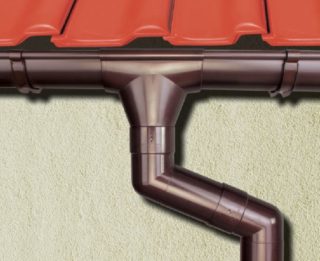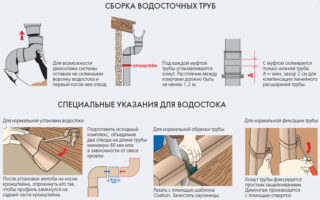To preserve the decorative finish of the walls and increase the service life of the foundation and blind area, it is necessary to ensure the drainage of rain and melt water from the building. Private and municipal construction projects need protection from excess moisture.
Varieties of gutters
- The gutters are used to receive melt and rainwater along the perimeter of the roof overhang.
- The connectors are designed for horizontal joining of the gutters.
- External and internal corner pieces are required for installing the ebb in the corners of the building.
- The funnel serves as a transitional element between the horizontal and vertical parts of the drainage system.
- Gutter plugs are used to prevent water from draining at the edges.
- Brackets are a fastening element for hanging the drainage system in the under-roof space and fastening the pipe to the facade of the building.
- The pipe is the vertical part of the drain. Designed to receive water from the gutter and drain the liquid down.
- The drain pipe bend, or elbow, serves to change the direction of the pipe. The detail is used to outline the protruding parts of the facade. There are elbows with a corrugated or fixed bend angle. The most common angles are 45, 60 and 90 degrees.
- The mark of the drainpipe is a kind of knee designed to remove water from the base.
- Protective elements. The gutter mesh and funnel cap keep leaves and other debris out of the system, preventing clogging.
Installation is carried out by elements of the same type, the combination of pipes and fittings of different systems is impractical.
Metal constructions

The drainage system must meet the following requirements:
- mechanical strength;
- chemical resistance;
- light weight;
- low cost;
- ease of installation.
Metal outflows of drainpipes, regardless of the alloy composition, have a common disadvantage - a high level of noise.
- Galvanized steel drainage systems do not corrode, have a relatively light weight and low cost.
- Pural, or galvanized polymer coated, is gaining popularity due to the choice of coating color. Pural products have high chemical resistance. During transportation and installation, care must be taken, because the polymer coating is quite fragile. Damage to the protective layer contributes to the formation of rust spots.
- Industrial-made aluminum sills are lacquered or permanently painted. They have sufficient resistance to negative natural influences. The elements are riveted using a sealant. You can save money by assembling the drainage system from metal sheets, bending them at the installation site.
- Copper gutters are beautiful, durable and expensive.
- Titanium-zinc gutters are considered to be the most durable, their service life exceeds 150 years. Due to the extremely high price, they were not used in mass construction.
When choosing metal products, it should be understood that when the product is deformed as a result of snow or ice melting, its consumer qualities are reduced.
Plastic constructions

PVC products are distinguished by high consumer qualities, combining:
- low cost;
- wide color spectrum;
- light weight;
- ease of installation;
- chemical resistance.
Unlike metal pipes, PVC pipes do not create noise during the drainage process. The mechanical strength of PVC drips is quite high, provided that the rules for installing the system are observed. A wide range of connecting and fastening elements, the presence of pipes and gutters of different diameters, allow you to collect drainage systems of complex configuration.
Installation of the drainage system
The calculation of the total length of the drainage system and its diameter is based on the area and slope of the roof. A specialist store consultant can help you select the correct brackets and fittings. Unified structural elements speed up the assembly process.
Installation of a horizontal section
Before starting work, it is necessary to mark the horizontal section of the catchment area. For the natural movement of water, it is necessary to maintain a slope within the range of 5 to 20 mm per linear meter. Depending on the roof structure, the brackets are attached to the rafter legs or to the wind board.
- Calculate the height difference based on the length of the roof slope.
- Fasten the first bracket so that a distance of at least 3 cm remains between the roof overhang and the top of the gutter. Failure to observe this rule will lead to the gutters breaking off during an avalanche.
- Mark the place of attachment of the last bracket at the calculated level, but do not fix it rigidly, later you will need to adjust it in height.
- Stretch the thread between the first and the last bracket, mark the attachment points for the intermediate brackets.
- Place the gutters, leaving 3-4 mm for linear expansion between them. For docking, use the connectors provided by the manufacturer.
- Attach plugs to the edges of the gutters.
It is not allowed to install the bracket under the connecting element.
The funnel of the drain pipe is located at a distance of 40-70 cm from the end of the gutter, so the last bracket must be raised 0.5-1 cm from the design height in order to ensure the movement of water to the funnel.
Gusset
Vertical section
The vertical part of the drainage system is collected from pipes. To change from the horizontal to the vertical part of the system, the knees must be used. The fewer bends, the less chance of clogging. The pipes are fastened to the wall using brackets. It is necessary to strictly maintain the vertical, checking the correct installation using a building level.
Drainage mark
Lastly, a drainage outlet is mounted. The height of the drain hole varies from 20 to 40 cm above the soil or blind area. The water throwing distance must be at least 50 cm from the building wall. It is possible to withdraw the drain into a storage tank, storm sewer, filtration well, drainage system or into the nearest reservoir.
Correct calculation and high-quality installation of the drainage system will extend the life of the building.










